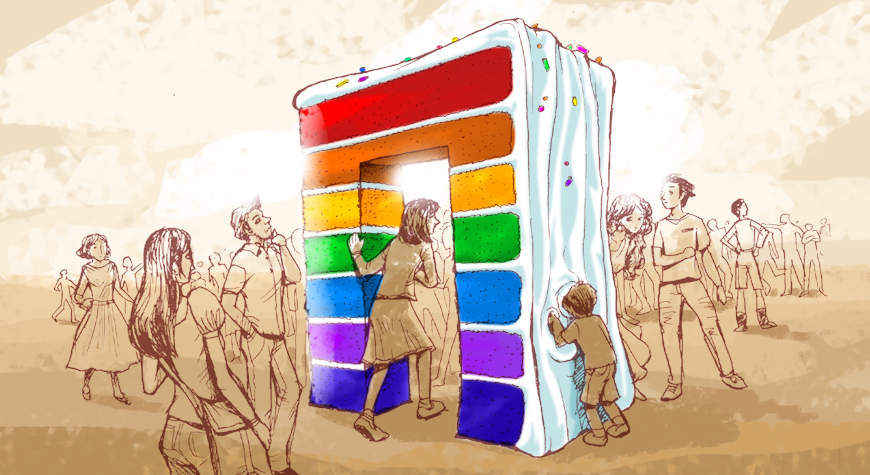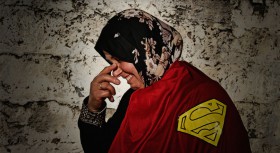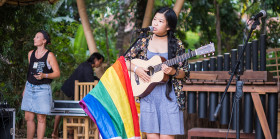When it comes to their representation in literature, the Indonesian Lesbian, Gay, Bisexual, Transgender, Intersex and Questioning (LGBTIQ) community may find themselves in some sort of a sluggish waltz dance. It's there, it's constant, it never really stops... but it somehow lacks color and vibrancy; something that does not do justice to the community's multi-hued symbol of the rainbow flag.
Sure, there has been more than a few local fictional works depicting queer characters and same-sex love stories; ranging from highbrow short story anthologies to best-selling pop novels. However, whether queer people are represented as diversely in those books remains a question.
Hendri Yulius, a young fiction writer and queer studies enthusiast, observes, "[Most of what I read] are stories with gay characters in them, but they are still using a heterosexual pattern. For example, a romance between two men is likely to involve an effeminate man and an ultra masculine one. [The stories] still struggle with issues like self-acceptance, using words like 'forbidden love', 'taboo', and so on."
Therefore, whenever a new local LGBTIQ-themed book hits the shelf, it's always interesting to check it out, even if just to see whether the stories and characters still talk about the same old thing, or if they have something new to offer.
Keep Calm and Be Fabulous, a new anthology from publisher Elex Media Komputindo, brings us six novellas from six writers and explores various modern queer subjects told in eclectic styles, which ultimately bring out some new perspectives.
The stories are classified into six independent chapters, each representing the letter L, G, B, T, I, Q. While commonly known to stand for Lesbian, Gay, Bisexual, Transgender, Intersex and Questioning, the letters also cleverly represent the theme of each story in the book: Love, Gifted, Bravery, Trust, Imagination and Quest.
The first story, called “H2H (Heart to Heart)”, which Hendri co-wrote with fellow writer Kindy Marina, is a light-hearted urban yarn about a girl trying to cope with falling for a colleague, who happens to be a gay man. Told through a series of e-mail conversations, the story examines how the girl struggles with her unrequited feelings and how the guy tries to deal with the delicate situation.
The story is interesting in the sense that while it discusses a somewhat banal subject, it is also refreshing in its depiction of its gay character. Ruben, the male protagonist, is an out-and-proud gay man with a successful corporate career, who cannot be more confident about his sexuality. Not only that, he also receives full support from his parents regarding this matter.
"I have gay friends who are in such good terms with their parents. [Kindy and I] would like to bring this to the surface. It is not impossible for parents to accept your sexuality," Hendri explains. "Many local LGBTIQ-themed stories end on somber notes – whether the protagonists die, or live on with unspoken feelings, or their lover leaves them for a heterosexual marriage. We just want to shed light on something more optimistic."
The book then shifts to a darker mood in Caca Kartiwa's “Ezra, dalam Fragmen” (Ezra, in Fragments); a lyrical, observant account of Indonesia's modern gay scene that is, at the same time, mysterious and ridden with haunting mysticism.
Ezra, a young man with a psychic ability, tries to use his gift to locate a lover gone missing in a forest expedition in Papua. Through almost erratic fragments of prose, we gather – piece by piece – Ezra's love story, self-discovery, and his fight for the love he believes in.
Beyond that, author Caca also juggles with issues like death and the environment.
"As human beings, we all have the same responsibility: to preserve the earth we live in, whether we are straight or gay," he says.
There's a memorable passage in the story, where Ezra muses on the similarities he shares with the mutants from the X-Men films. The analogy is interesting not only because it compares the X-Men to the queer community (which is quite obvious; the queer analogy in the X-Men mythology has long been spotted and discussed since the first X-Men film, which was directed by Bryan Singer, himself an openly gay filmmaker), but because it also refers to Ezra's state of isolation as a person with a psychic ability. In this case, he is a "double mutant." That's why the mutant analogy seems fitting, not only for the film's queer undertone, which makes the story's central character all the more nuanced and appealing.
From this story, the book maneuvers to a more conventional terrain with El Ayn Morve's “Labirin” (Labyrinth), which tells the story of a university student dealing with her feelings for her female professor, while a more “orthodox” popular guy on campus is also trying to win her over.
"[My character] is dealing with what happens when admiration turns to attraction," El Ayn Morve elaborates.
Then follows Amal Azwar's “Husbro”, a witty comedy of manners on urban gay problems, told through the eyes of a lovesick magazine editor and his best friend, a free-spirited, matter-of-fact male hustler. It is a free, wisecracking, unapologetic observation that offers an optimistic view on issues otherwise perceived as grave.
"I just wanted to write a gay love story with a happy ending, but also to be realistic at the same time. I am so tired of reading or watching gay fiction with sad endings, especially in mainstream media," Amal says.
The fifth story is Bintang Pradipta's “Ular Tangga” (Snakes and Ladders), about a young guy lamenting the impending departure of a lover. Contrary to the potentially sentimental premise, though, the story is a clever, endearing, at times esoteric musing filled with dry humor that draws us into the mind of its cynical protagonist.
"I just would like to make my character feel human, and not be patronizing with what I write," Bintang says.
And this brings us to the final story, "Boy Meets Girl, Boy Meets Boy, Girl Meets Girl, and... U Meets I", another collaboration of Hendri Yulius and Kindy Marina. The book's final act taps into a more complicated realm, flirting with sexuality in its most fluid form and brushing with issues like the less-talked-about female-to-male transgenderism. What makes it more intriguing is that these complex issues are explored in the simplest of ways: a series of Whatsapp conversations.
'U Meets I' concludes our journey through Keep Calm and Be Fabulous. However, the journey of the book itself in making it to the shelf is not a smooth one. Two days before its scheduled release date back in August of 2014, the publisher fell under scrutiny due to the controversy on sexuality issues surrounding one of its adapted children books. Consequently, they decided to postpone the release of the LGBTIQ-themed novella anthology, and the book had to sit in the storage for five months.
Fortunately, in January of 2015, they went on with the eventual release, after changing the book's title from L.G.B.T.I.Q. to the less provocative Keep Calm and Be Fabulous. As Hendri wrote in the book's foreword, this new title reflects the writers' political stand: to stay composed and keep producing work – fabulous work, that is – despite any challenges.
So, the six stories finally made its way through, and become the latest addition in Indonesia's LGBTIQ-themed fiction circuit, with somewhat fresher characters in dealing with sexuality issues.
"We just aim to depict LGBTIQ characters as naturally as possible. Sure, some of them still struggle with their selves and guilt – like it or not, it is still a relevant issue – but we don't want our stories to dwell on that too much," explains Hendri.
"Everyone, no matter what their sexual orientation is, has problems. You only live once. So be positive, fight for what you think is right, be tolerant, and be happy," adds Kindy.
At the end of the day, Hendri hopes that after reading this book, all readers will find that LGBTIQ people are just like any other people. "It's that simple, really," he concludes.
Just like "any other people", the LGBTIQ community is marching through life with issues and problems beyond their sexuality, which makes them as diverse, multi-dimensional and colorful as their heterosexual counterparts, as proudly reflected in Keep Calm and Be Fabulous' rainbow-colored cover.
Keep Calm and Be Fabulous; Amal Azwar, Bintang Pradipta, Caca Kartiwa, El Ayn Morve, Hendri Yulius, Kindy Marina; published by Elex Media Komputindo, January 2015, 298 pages, in Bahasa Indonesia.
Rizal Iwan is a Jakarta-based freelance writer, a film columnist for a monthly magazine, and is currently trying his luck writing fiction.
Illustration by Alam Taslim.








Comments